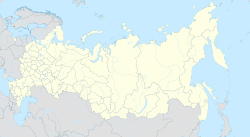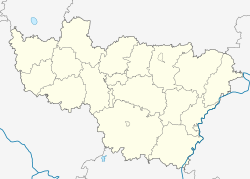world.wikisort.org - Russia
Murom (Russian: Муром, IPA: [ˈmurəm]; Old Norse: Moramar) is a historical city in Vladimir Oblast, Russia, which sprawls along the left bank of the Oka River. Population: 107,497 (2021 Census);[11] 116,075 (2010 Census);[4] 126,901 (2002 Census);[12] 124,229 (1989 Census).[13]
This article may be expanded with text translated from the corresponding article in Russian. (July 2019) Click [show] for important translation instructions.
|
Murom
Муром | |
|---|---|
City[1] | |
 Murom Transfiguration monastery | |
 Flag  Coat of arms | |
Location of Murom  | |
 Murom Location of Murom  Murom Murom (Vladimir Oblast) | |
| Coordinates: 55°34′N 42°02′E | |
| Country | Russia |
| Federal subject | Vladimir Oblast[2] |
| First mentioned | 862 |
| Government | |
| • Head[3] | Yevgeny Rychkov[3] |
| Elevation | 115 m (377 ft) |
| Population | |
| • Total | 116,075 |
| • Estimate (2018)[5] | 109,072 (−6%) |
| • Rank | 140th in 2010 |
Administrative status | |
| • Subordinated to | City of Murom[2] |
| • Capital of | Muromsky District[6], City of Murom[2] |
Municipal status | |
| • Urban okrug | Murom Urban Okrug[7] |
| • Capital of | Murom Urban Okrug[7], Muromsky Municipal District[8] |
| Time zone | UTC+3 (MSK |
| Postal code(s)[10] | 602250 |
| Dialing code(s) | +7 49234 |
| OKTMO ID | 17735000001 |
| Website | www |
History
In the 9th century AD, the city marked the easternmost settlement of the East Slavs in the land of the Finnic Muromians. The Primary Chronicle mentions it as early as AD 862.[14] It is thus one of the oldest cities in Russia. Circa 900 AD, it was an important trading post from Volga Bulgaria to the Baltic Sea.
Between AD 1010 and AD 1393, it was the capital of a separate principality, whose rulers included Saint Gleb, assassinated in AD 1015 and canonized in AD 1071, Saint Prince Konstantin the Blessed, and Saints Peter and Fevronia of Murom, subjects of an opera by Rimsky-Korsakov. It was believed to be the home town of the most celebrated East Slavic epic hero, Ilya Muromets. The town has a statue which shows Ilya holding the hilt of his sword in the left hand and a cross in the right.
On June 30, 1961, Murom was the site of a spontaneous protest and riot against the police and Soviet authorities, following the death in police custody of a senior factory foreman named Kostikov.[15]
Administrative and municipal status
Within the framework of administrative divisions, Murom serves as the administrative center of Muromsky District,[6] even though it is not a part of it.[1] As an administrative division, it is incorporated separately as the City of Murom—an administrative unit with the status equal to that of the districts.[2] As a municipal division, the territory of the City of Murom together with nine rural localities in Muromsky District are incorporated as Murom Urban Okrug.[1][7]
Sights
- Three historic abbeys in the city center
- The main church of the Holy Trinity Monastery (1642-1643)
- Painting by Ivan Kulikov 1914
- Aerial view of the city in 2014
Murom still retains many marks of antiquity. The Savior monastery, one of the most ancient in Russia, was first chronicled in 1096, when Oleg of Chernigov besieged it and killed Vladimir Monomakh's son Izyaslav, who is buried there. In 1552, the monastery was visited by Ivan the Terrible who commissioned a stone cathedral, which was followed by other churches.
The Trinity convent, where the relics of Sts. Peter and Fevronia are displayed, features a fine cathedral (1642–1643), Kazan church (1652), a bell-tower (1652), a wooden church of St. Sergius, and stone walls. It is rivaled by the Annunciation Monastery, founded in the reign of Ivan the Terrible to house the relics of local princes and containing a cathedral from 1664. Two last-mentioned cathedrals, being probably the works of the same masters, have much in common with the Resurrection Church (1658) in the downtown. Quite different is the tent-like church of Sts. Cosmas and Damian, built in 1565 on the bank of the Oka to commemorate the Russian conquest of Kazan.
International relations
Twin towns — Sister cities
Murom is twinned with:
 Most, Czech Republic
Most, Czech Republic Babruysk, Belarus
Babruysk, Belarus
Notable people
Among notable natives are the father of color photography, Sergey Prokudin-Gorsky (1863), the painter Ivan Kulikov[16](1875) and the father of television, Vladimir Zworykin (1888) and Russian physicist Igor Irodov.
References
Notes
- Resolution #433
- Law #130-OZ
- Official website of Murom Urban Okrug. Yevgeny Rychkov, Head of the Urban Okrug Archived March 23, 2011, at the Wayback Machine (in Russian)
- Russian Federal State Statistics Service (2011). Всероссийская перепись населения 2010 года. Том 1 [2010 All-Russian Population Census, vol. 1]. Всероссийская перепись населения 2010 года [2010 All-Russia Population Census] (in Russian). Federal State Statistics Service.
- "26. Численность постоянного населения Российской Федерации по муниципальным образованиям на 1 января 2018 года". Federal State Statistics Service. Retrieved January 23, 2019.
- Государственный комитет Российской Федерации по статистике. Комитет Российской Федерации по стандартизации, метрологии и сертификации. №ОК 019-95 1 января 1997 г. «Общероссийский классификатор объектов административно-территориального деления. Код 17 244», в ред. изменения №278/2015 от 1 января 2016 г.. (State Statistics Committee of the Russian Federation. Committee of the Russian Federation on Standardization, Metrology, and Certification. #OK 019-95 January 1, 1997 Russian Classification of Objects of Administrative Division (OKATO). Code 17 244, as amended by the Amendment #278/2015 of January 1, 2016. ).
- Law #53-OZ
- Law #58-OZ
- "Об исчислении времени". Официальный интернет-портал правовой информации (in Russian). June 3, 2011. Retrieved January 19, 2019.
- Почта России. Информационно-вычислительный центр ОАСУ РПО. (Russian Post). Поиск объектов почтовой связи (Postal Objects Search) (in Russian)
- Russian Federal State Statistics Service. Всероссийская перепись населения 2020 года. Том 1 [2020 All-Russian Population Census, vol. 1] (XLS) (in Russian). Federal State Statistics Service.
- Russian Federal State Statistics Service (May 21, 2004). Численность населения России, субъектов Российской Федерации в составе федеральных округов, районов, городских поселений, сельских населённых пунктов – районных центров и сельских населённых пунктов с населением 3 тысячи и более человек [Population of Russia, Its Federal Districts, Federal Subjects, Districts, Urban Localities, Rural Localities—Administrative Centers, and Rural Localities with Population of Over 3,000] (XLS). Всероссийская перепись населения 2002 года [All-Russia Population Census of 2002] (in Russian).
- Всесоюзная перепись населения 1989 г. Численность наличного населения союзных и автономных республик, автономных областей и округов, краёв, областей, районов, городских поселений и сёл-райцентров [All Union Population Census of 1989: Present Population of Union and Autonomous Republics, Autonomous Oblasts and Okrugs, Krais, Oblasts, Districts, Urban Settlements, and Villages Serving as District Administrative Centers]. Всесоюзная перепись населения 1989 года [All-Union Population Census of 1989] (in Russian). Институт демографии Национального исследовательского университета: Высшая школа экономики [Institute of Demography at the National Research University: Higher School of Economics]. 1989 – via Demoscope Weekly.
- Hazzard Cross; Samuel and Sherbowitz-Wetzor; Olgerd P. (1953). The Russian Primary Chronicle: Laurentian Text (PDF). Medieval Academy of America, Cambridge, MA. pp. 59–60.
- Kozlov, Vladimir A.; McClarnand MacKinnon, Elaine (2002). Mass uprisings in the USSR: protest and rebellion in the post-Stalin years. ISBN 9780765606686.
- Brief biography and appreciation Archived 2013-01-10 at archive.today @ the Museum of Nizhny Novgorod State University
Sources
- Законодательное Собрание Владимирской области. Закон №130-ОЗ от 10 декабря 2001 г. «Об административно-территориальном устройстве Владимирской области и о порядке его изменения», в ред. Закона №22-ОЗ от 18 марта 2014 г. «О признании утратившими силу части 1 статьи 15 Закона Владимирской области "Об административно-территориальном устройстве Владимирской области и о порядке его изменения" и пункта 3 статьи 1 Закона Владимирской области "О внесении изменений в Закон Владимирской области "Об административно-территориальном устройстве Владимирской области и о порядке его изменения"». Вступил в силу со дня официального опубликования (13 декабря 2001 г.). Опубликован: "Владимирские ведомости", №232, 13 декабря 2001 г. (Legislative Assembly of Vladimir Oblast. Law #130-OZ of December 10, 2001 On the Administrative-Territorial Structure of Vladimir Oblast and on Procedures for Its Change, as amended by the Law #22-OZ of March 18, 2014 On Abrogating Part 1 of Article 15 of the Law of Vladimir Oblast "On the Administrative-Territorial Structure of Vladimir Oblast and on Procedures for Its Change" and Item 3 of Article 1 of the Law of Vladimir Oblast "On Amending the Law of Vladimir Oblast "On the Administrative-Territorial Structure of Vladimir Oblast and on Procedures for Its Change". Effective as of the day of the official publication (December 13, 2001).).
- Администрация Владимирской области. Постановление №433 от 13 июня 2007 г. «О реестре административно-территориальных образований и единиц Владимирской области», в ред. Постановления №169 от 5 марта 2015 г. «О внесении изменения в Постановление Губернатора области от 13.06.2007 №433 "О реестре административно-территориальных образований и единиц Владимирской области"». Вступил в силу со дня официального опубликования. Опубликован: "Владимирские ведомости", №114, 20 июня 2007 г. (Administration of Vladimir Oblast. Resolution #433 of June 13, 2007 On the Registry of the Administrative-Territorial Formations and Units of Vladimir Oblast, as amended by the Resolution #169 of March 5, 2015 On Amending Resolution #433 of the Oblast Governor of June 13, 2007 "On the Registry of the Administrative-Territorial Formations and Units of Vladimir Oblast". Effective as of the day of the official publication.).
- Законодательное Собрание Владимирской области. Закон №53-ОЗ от 11 мая 2005 г. «О наделении статусом городского округа муниципального образования округ Муром и установлении его границы», в ред. Закона №85-ОЗ от 12 октября 2011 г «О внесении изменений в Приложения 1 и 2 к Закону Владимирской области "О наделении статусом городского округа муниципального образования округ Муром и установлении его границы"». Вступил в силу 17 мая 2005 г. Опубликован: "Владимирские ведомости", №156–157, 17 мая 2005 г. (Legislative Assembly of Vladimir Oblast. Law #53-OZ of May 11, 2005 On Granting Urban Okrug Status to the Municipal Formation of the Okrug of Murom and on Establishing Its Border, as amended by the Law #85-OZ of October 12, 2011 On Amending Appendices 1 and 2 to the Law of Vladimir Oblast "On Granting Urban Okrug Status to the Municipal Formation of the Okrug of Murom and on Establishing Its Border". Effective as of May 17, 2005.).
- Законодательное Собрание Владимирской области. Закон №58-ОЗ от 13 мая 2005 г. «О наделении соответствующим статусом вновь образованного муниципального образования Муромский район и вновь образованных муниципальных образований, входящих в его состав, и установлении их границ», в ред. Закона №115-ОЗ от 10 августа 2009 г «О внесении изменений в Закон Владимирской области "О наделении соответствующим статусом вновь образованного муниципального образования Муромский район и вновь образованных муниципальных образований, входящих в его состав, и установлении их границ"». Вступил в силу со дня официального опубликования (18 мая 2005 г.). Опубликован: "Владимирские ведомости", №№158–165, 18 мая 2005 г. (Legislative Assembly of Vladimir Oblast. Law #58-OZ of May 13, 2005 On Granting an Appropriate Status to the Newly Established Municipal Formation of Muromsky District and to the Newly Established Municipal Formations Which Comprise It, and on Establishing Their Borders, as amended by the Law #115-OZ of August 10, 2009 On Amending the Law of Vladimir Oblast "On Granting an Appropriate Status to the Newly Established Municipal Formation of Muromsky District and to the Newly Established Municipal Formations Which Comprise It, and on Establishing Their Borders". Effective as of the day of the official publication (May 18, 2005).).
На других языках
[de] Murom
Murom (russisch Му́ром) ist eine russische Stadt mit 116.075 Einwohnern (Stand 14. Oktober 2010)[1] in der Oblast Wladimir, 290 km östlich von Moskau an der Eisenbahnstrecke Moskau – Kasan.- [en] Murom
[ru] Муром
Му́ром — город в России, административный центр городского округа Муром и центральный город Муромского района (в состав района не входит) Владимирской области. Население города — 105 572[2] чел. (2021).Другой контент может иметь иную лицензию. Перед использованием материалов сайта WikiSort.org внимательно изучите правила лицензирования конкретных элементов наполнения сайта.
WikiSort.org - проект по пересортировке и дополнению контента Википедии



